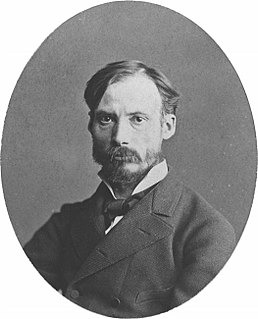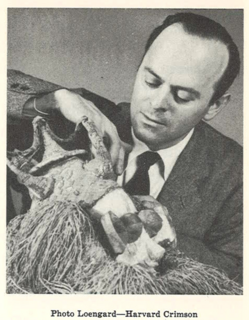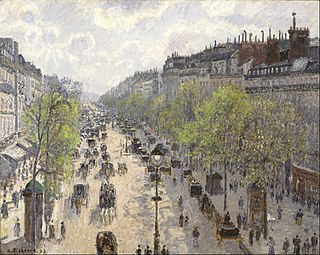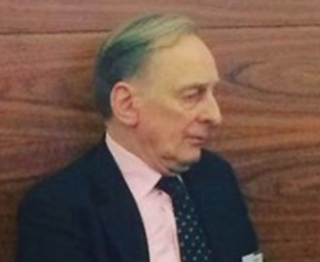Related Research Articles

Camille Pissarro was a Danish-French Impressionist and Neo-Impressionist painter born on the island of St Thomas. His importance resides in his contributions to both Impressionism and Post-Impressionism. Pissarro studied from great forerunners, including Gustave Courbet and Jean-Baptiste-Camille Corot. He later studied and worked alongside Georges Seurat and Paul Signac when he took on the Neo-Impressionist style at the age of 54.

Pierre-Auguste Renoir was a French artist who was a leading painter in the development of the Impressionist style. As a celebrator of beauty and especially feminine sensuality, it has been said that "Renoir is the final representative of a tradition which runs directly from Rubens to Watteau."

Art theft, sometimes called artnapping, is the stealing of painting or sculpture from galleries or museums. Art is sometimes used by criminals as collateral to secure loans. Only a small percentage of stolen art is recovered—estimates range from 5 to 10%. Some nations operate police squads to investigate art theft.

Nazi plunder was stealing of art and other items as a result of the organized looting of European countries during the time of the Third Reich by agents acting on behalf of the ruling Nazi Party of Germany. The looting of Jewish property was a key part of the Holocaust. Plundering occurred from 1933, beginning with the seizure of property of German Jews, until the end of World War II, particularly by military units known as the Kunstschutz, although most plunder was acquired during the war. In addition to gold, silver and currency, cultural items of great significance were stolen, including paintings, ceramics, books and religious treasures.

John Rewald was an American academic, author and art historian. He was known as a scholar of Impressionism, Post-Impressionism, Cézanne, Renoir, Pissarro, Seurat, and other French painters of the late 19th century. He was recognized as a foremost authority on late 19th-century art. His History of Impressionism is a standard work.
Judith Helen Dobrzynski is an American journalist and instructor in journalism. She is currently a freelance writer who has contributed articles on culture, the arts, business, philanthropy and other topics to The New York Times, The Wall Street Journal and several magazines.

Hector Feliciano is a Puerto Rican journalist and author whose book "The Lost Museum: The Nazi Conspiracy to Steal the World's Greatest Works of Art" has shed light on an estimated 20,000 works of art plundered by the Nazis; each one is owned by a museum or a collector somewhere.

Robert King "Bob" Wittman is a highly decorated former Federal Bureau of Investigation special agent who was assigned to the Philadelphia Field Division from 1988 to 2008. Having trained in art, antiques, jewelry and gem identification, Wittman served as the FBI's "top investigator and coordinator in cases involving art theft and art fraud". During his 20 years with the FBI, Wittman helped recover more than $300 million worth of stolen art and cultural property, resulting in the prosecution and conviction of numerous individuals. In 2005, he was instrumental in the creation of the FBI's rapid deployment Art Crime Team (ACT). He was named the ACT's senior investigator and was responsible for instructing the newly formed team. He also was instrumental in the recovery of colonial North Carolina's copy of the original Bill of Rights in 2005, that had been stolen by a Union soldier in 1865. Wittman represented the United States around the world, conducting investigations and instructing international police and museums in recovery and security techniques. After 20 years with the FBI working against art theft, he worked as an art security consultant for the private sector. In 2010 Wittman published his memoir Priceless which recounts his career and activities while working for the FBI as an undercover agent.
William Henry Gerdts Jr. was an American art historian and professor of Art History at the CUNY Graduate Center. Gerdts was the author of over twenty-five books on American art. An expert in American Impressionism, he was also well known for his work on nineteenth-century American still life painting.

The Regatta at Sainte-Adresse is an oil-on-canvas painting by the impressionist painter Claude Monet. It was painted in 1867 and is owned by the Metropolitan Museum of Art.
Art theft and looting occurred on a massive scale during World War II. It originated with the policies of the Axis countries, primarily Nazi Germany and Japan, which systematically looted occupied territories. Near the end of the war the Soviet Union, in turn, began looting reclaimed and occupied territories. "The grand scale of looted artwork by the Nazis has resulted in the loss of many pieces being scattered across the world."
Art Loss Register (ALR) is the world's largest database of stolen art. A computerized international database that captures information about lost and stolen art, antiques, and collectibles, the ALR is a London-based, independent, for-profit corporate offspring of the New York-based, nonprofit International Foundation for Art Research (IFAR). The range of functions served by ALR has grown as the number of its listed items has increased. The database is used by collectors, the art trade, insurers, and law enforcement agencies worldwide. In 1991, IFAR helped create the Art Loss Register (ALR) as a commercial enterprise to expand and market the database. IFAR managed ALR's U.S. operations through 1997. In 1998 the ALR assumed full responsibility for the IFAR database although IFAR retains ownership. In 1992, the database comprised only 20,000 items, but it grew in size nearly tenfold during its first decade.

Harry Bober (1915–1988) was an American art historian, a university professor, and a writer. He was the first Avalon Professor of the Humanities a New York University (NYU). He wrote and edited several books and published numerous articles on the art, architecture and historiography of the Middle Ages and the early Renaissance period.
Bonnie Burnham is an American art historian who is a former head of World Monuments Fund (WMF). She joined the organization as executive director in 1985, and was named president in 1996.

Le Boulevard de Montmartre, Matinée de Printemps is an 1897 oil on canvas painting of Paris' Boulevard Montmartre by the French artist Camille Pissarro.

Dance at Bougival is an 1883 work by Pierre-Auguste Renoir, currently in the collection of the Museum of Fine Arts in Boston, Massachusetts, USA. Described as "one of the museum's most beloved works", it is one of three in a collection commissioned by Paul Durand-Ruel. It depicts a scene in the French village of Bougival, about 15 km from the center of Paris, a site utilized by many Impressionists other than Renoir including Claude Monet, Alfred Sisley, and Berthe Morisot.

Julian Guy Yonge Radcliffe is a British businessman, and the founder and chairman of the Art Loss Register (ALR).

Caracas Museum of Contemporary Art is a museum of modern art located in the Parque Central Complex in Caracas, Venezuela. It was founded on 30 August 1973 by the journalist and art patron Sofía Ímber, also its director from 1973 to her dismissal in the Chavist cultural revolution of 2001. It opened in 1974 and was the first museum in Venezuela to offer a specialist art library, a formal children's and adults' learning area, a special education department for the blind, and a multimedia arts centre.

Many priceless artworks by the Dutch post-impressionist artist Vincent van Gogh were looted by Nazis during the Third Reich (1933-1945), mostly from Jewish collectors forced into exile or murdered.
References
- Feliciano, Hector. (1997). The Lost Museum: The Nazi Conspiracy to Steal the World's Greatest Works of Art. New York: Basic Books. ISBN 978-0-465-04194-7; OCLC 36446851
- Houpt, Simon and Julian Radcliffe. (2006). Museum of the Missing: a History of Art Theft. New York: Sterling Publishing. ISBN 978-1-4027-2829-7; OCLC 67375076
- Nicholas, Lynn H. (1994). The Rape of Europa: The Fate of Europe’s Treasures in the Third Reich and the Second World War. New York City: Vintage Books. ISBN 978-0-679-40069-1; OCLC 32531154